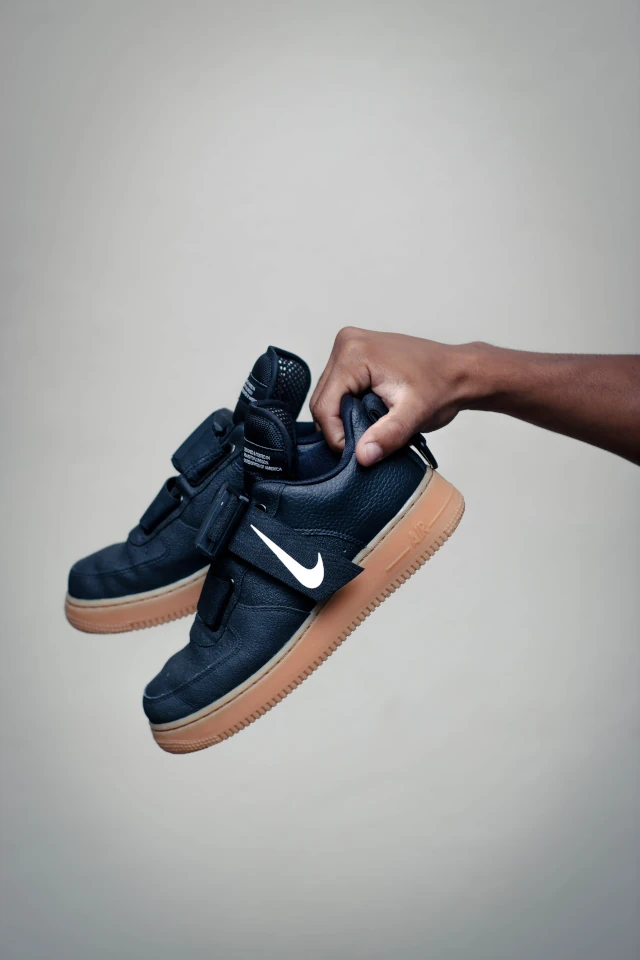Welcome to our explanation of Nike’s marketing strategy, one of the world’s most iconic sports and lifestyle brands. We’ll examine the layers of Nike’s approach, exploring how their blend of innovation, powerful branding, celebrity endorsements, and digital prowess has not only revolutionized the sports apparel industry but also created a blueprint for modern marketing. From their inspiring “Just Do It” slogan to their commitment to sustainability and inclusivity, Nike’s strategy offers invaluable insights into building a brand that resonates globally.

Innovation as a Driving Force:
Nike’s marketing strategy is a testament to the power of innovation as a cornerstone of brand success. The company’s commitment to research and development has continuously set new benchmarks in sports apparel and footwear. This unyielding pursuit of technological advancement is not just about creating superior products, but it also serves as a critical component of their marketing narrative.
At the heart of Nike’s innovation strategy lies a deep understanding of athletes’ needs. This athlete-centric approach has led to groundbreaking products that revolutionize the way sports are played and experienced. For instance, the Air Max technology, which incorporates air cushioning in the soles, was not just an advancement in shoe comfort; it became a cultural icon. Similarly, Nike’s Dri-FIT technology, which offers moisture-wicking fabrics to keep athletes dry and comfortable, exemplifies how the brand integrates functionality with comfort.
However, it’s not just about the technology itself, but how Nike markets these innovations. The introduction of Flyknit technology, which uses high-strength fibers to create lightweight, formfitting shoes, was a game-changer in footwear. But Nike’s marketing brilliance shone through in how they presented Flyknit. They didn’t just sell a shoe; they sold a story of precision engineering, sustainability (reducing material waste), and peak performance. This narrative resonated deeply with environmentally conscious consumers and athletes alike, illustrating how Nike’s marketing strategy goes beyond selling products to selling experiences and values.
Nike’s approach to innovation in marketing extends beyond product features. It’s about weaving these advancements into the fabric of their brand story. Each technological breakthrough is not just a launch; it’s an event, an opportunity to engage with their audience, and reaffirm their position as pioneers in sports technology. This strategy not only fortifies their brand image but also fosters a loyal customer base that eagerly anticipates each new Nike innovation.
In essence, Nike’s marketing strategy, rooted in innovation, is a blend of scientific advancement and storytelling. It’s a powerful combination that keeps the brand at the forefront of the sports industry, continually setting the pace and defining the future of athletic wear.
Branding: Crafting a Powerful Narrative:
Nike’s branding strategy, particularly its narrative crafting, stands as a pillar of its marketing success. The brand’s iconic slogan, “Just Do It,” transcends the realm of advertising, embedding itself into the cultural lexicon. This simple yet powerful phrase encapsulates the essence of the Nike brand – determination, resilience, and the relentless pursuit of goals. But the impact of Nike’s branding goes far beyond a catchy slogan; it’s about the story they tell and the emotional connection they forge with their audience.

The genius of Nike’s branding lies in its ability to weave compelling stories that resonate with a diverse audience. Through their advertising campaigns, Nike doesn’t just promote products; they showcase stories of triumph, struggle, and perseverance. These narratives often feature not only elite athletes but also everyday people who are striving to overcome their personal challenges. This approach humanizes the brand, making it more relatable and inspirational to its global audience.
Nike’s storytelling is not confined to conventional mediums. Their campaigns often utilize a mix of traditional and digital platforms to create immersive experiences. For instance, their video advertisements are known for their high production value and emotional appeal, often going viral on social media. These stories are not just advertisements; they are conversation starters, motivational tools, and, at times, cultural statements.
A crucial aspect of Nike’s branding strategy is its inclusivity. They actively work to represent a variety of athletes from different backgrounds, genders, and abilities. This commitment to diversity not only broadens their appeal but also strengthens their brand identity as an inclusive, progressive company. It’s a strategy that not only sells products but also builds a loyal community around the brand.
In a world where consumers are bombarded with countless marketing messages, Nike’s branding stands out. Their approach to storytelling doesn’t just capture attention; it engages hearts and minds. This emotional engagement is what makes Nike’s branding so effective and enduring, solidifying their status as more than just a sports brand, but as a symbol of aspiration and inspiration.
Celebrity Endorsements and Sponsorships:
Nike’s marketing strategy has been significantly bolstered by its use of celebrity endorsements and sponsorships, a tactic that has proven immensely effective in increasing brand visibility and appeal. The company has meticulously selected high-profile athletes who not only excel in their respective sports but also embody the brand’s values of determination, excellence, and innovation. These partnerships are not mere business transactions; they are strategic alignments that enhance Nike’s brand narrative.
The impact of these endorsements is exemplified by Nike’s long-standing relationship with Michael Jordan. This partnership did more than just sell sneakers; it revolutionized the sports marketing industry. The Air Jordan brand, stemming from this collaboration, became a cultural phenomenon, intertwining basketball, fashion, and personal style. It demonstrated how an athlete’s persona could elevate a brand’s status and connect with consumers on a profound level.
Similarly, Nike’s association with Serena Williams extends beyond traditional sports endorsements. Williams, a powerhouse in tennis and a symbol of strength and resilience, aligns perfectly with Nike’s brand ethos. Through this partnership, Nike doesn’t just showcase its products; it champions diversity, empowerment, and the breaking of barriers, which resonates powerfully with audiences worldwide.
Nike also strategically partners with sports teams and events to maximize its brand exposure. By sponsoring teams in major leagues and high-profile sporting events, Nike ensures a consistent presence in the public eye. These sponsorships are carefully chosen to reflect Nike’s image as a top-tier sports brand and to maintain relevance in various sports disciplines.
These endorsements and sponsorships form a vital part of Nike’s marketing strategy, serving as more than just promotional tools. They embody the brand’s values, tell its story, and build emotional connections with consumers. By aligning with athletes and teams that mirror their brand ethos, Nike has successfully created a powerful and relatable brand identity. This approach has not only solidified Nike’s position in the sports industry but has also set a benchmark for sports marketing globally.
Digital Marketing and Social Media Presence:
Nike’s digital marketing and social media strategy is a cornerstone of its overall marketing approach, showcasing a masterful blend of innovation and engagement. The brand has adeptly navigated the digital landscape, leveraging various online platforms to strengthen its connection with consumers. This strategy is multifaceted, encompassing social media presence, mobile apps, and a strong online sales platform.
Social media is a critical element of Nike’s digital strategy. The brand effectively uses platforms like Instagram, Twitter, and Facebook not just to promote products, but to tell stories, inspire athletes, and engage with its audience. These platforms serve as a canvas for Nike’s creative campaigns, allowing them to reach a vast audience with targeted, compelling content. Nike’s social media feeds are a mix of product announcements, athlete stories, motivational content, and user-generated material, creating an engaging and diverse online presence.

Additionally, Nike has harnessed the power of mobile technology through apps like Nike Training Club and Nike Run Club. These apps offer more than just product promotion; they provide value to the users in the form of training programs, tracking tools, and community engagement features. This approach turns a simple app into a daily part of consumers’ lives, deepening their connection to the Nike brand.
The brand’s online sales strategy is another vital component. Nike has developed a seamless e-commerce experience, making it easy for consumers to browse, select, and purchase products from the comfort of their homes. This strategy has been particularly effective in catering to the modern consumer’s preference for online shopping, further solidified by the global shift towards digital platforms in the wake of the COVID-19 pandemic.
In essence, Nike’s digital marketing and social media strategy is not just about selling products; it’s about creating an immersive brand experience. By effectively utilizing digital platforms, Nike has managed to stay relevant and engaging in an ever-evolving digital world. This strategy has not only helped in maintaining a strong brand presence but has also played a crucial role in driving sales and fostering a loyal customer base.
Emphasis on Customer Experience and Community Building:
Nike’s emphasis on customer experience and community building is a key aspect of its marketing strategy, reflecting the brand’s understanding that today’s consumers seek more than just products – they crave experiences and a sense of belonging. This focus extends across both digital and physical realms, aiming to create a cohesive and engaging brand experience for every customer.
In the digital space, Nike excels at creating an online community that goes beyond mere transactions. Its website and mobile apps are designed to be more than just shopping platforms; they serve as hubs for athletes and fitness enthusiasts. Features like personalized training plans, activity tracking, and community challenges on apps like Nike Training Club and Nike Run Club encourage regular interaction, fostering a sense of community among users. This approach not only keeps customers engaged with the brand but also integrates Nike into their daily lives.
In the physical world, Nike’s retail stores are designed to offer unique experiences. They are more than just shops; they are spaces where customers can interact with the brand on a deeper level. From interactive product displays to personalized services like expert fittings and customizations, these stores provide a hands-on experience that online shopping cannot replicate. Additionally, Nike often hosts events, product launches, and athlete meet-and-greets in their stores, further strengthening the community feel.
Furthermore, Nike’s community initiatives extend to broader, more inclusive campaigns. Programs like Nike Run Clubs and sports camps not only promote health and fitness but also bring people together, reinforcing the brand’s commitment to fostering a strong, inclusive community. These initiatives resonate particularly well with a customer base that values social connection and shared experiences.
Nike’s focus on customer experience and community building is a testament to its understanding of modern consumer desires. By offering engaging experiences and fostering a sense of community, Nike doesn’t just sell products; it builds lasting relationships with its customers. This strategy not only enhances brand loyalty but also solidifies Nike’s position as a lifestyle brand, deeply integrated into the lives of its consumers.
Global Reach with Localized Strategies:
Nike’s global reach is a testament to its adeptness in tailoring marketing strategies to diverse markets. While maintaining a cohesive global brand image, Nike recognizes the importance of localizing its approach to resonate with different cultures and consumer preferences around the world. This nuanced understanding of global and local dynamics is a crucial element of their marketing success.
In various countries, Nike adjusts its marketing campaigns to reflect local cultures, sports preferences, and consumer behaviors. For example, in soccer-dominated regions like Europe and South America, Nike focuses heavily on football-related products and sponsorships. This localization strategy extends to advertising, where local athletes and cultural references are often featured, creating a more relatable and authentic connection with the audience.
Nike also demonstrates cultural sensitivity in its global marketing approach. The brand is careful to respect and celebrate cultural differences, which is evident in its product lines and marketing campaigns that cater to local festivals, traditions, and lifestyles. For instance, special edition products for events like the Chinese New Year or local sports tournaments showcase Nike’s commitment to embracing and honoring diverse cultures.
Another aspect of Nike’s localized strategy is its response to regional market trends and consumer needs. In some markets, Nike places more emphasis on certain product lines based on local popularity. This agility in adapting to local preferences not only boosts sales but also enhances the brand’s relevance and appeal in different regions.
This global yet localized strategy has allowed Nike to maintain a strong presence in various markets worldwide. By understanding and embracing the uniqueness of each market, Nike successfully navigates the complex landscape of global marketing. This approach not only ensures the brand’s widespread appeal but also fosters a deeper connection with consumers across different cultures. As a result, Nike’s marketing strategy is not just about selling products globally; it’s about creating a globally resonant, yet locally relevant brand.
Sustainability and Social Responsibility:
Nike’s marketing strategy has evolved to include a strong focus on sustainability and social responsibility, recognizing these as crucial aspects of modern branding. This shift reflects an understanding that today’s consumers value brands that are not only innovative and trendy but also socially and environmentally conscious. Nike’s integration of these values into its marketing strategy is a forward-thinking move that resonates with a global audience increasingly concerned about these issues.
A significant component of Nike’s sustainable approach is the development and promotion of environmentally friendly products. Initiatives like using recycled materials in their products and innovating in sustainable manufacturing processes are not just business practices; they’re integral parts of Nike’s marketing narrative. This commitment to sustainability is highlighted in their campaigns, reinforcing the brand’s image as a responsible and forward-thinking leader in the sports industry.
In addition to environmental sustainability, Nike focuses on social responsibility in its marketing strategy. This includes efforts to promote diversity, inclusion, and fair labor practices. Campaigns that celebrate diversity in sports and advocate for social issues resonate with consumers who seek brands that align with their values. By addressing these societal concerns and taking a stand, Nike builds a deeper, more meaningful connection with its customer base.
Nike’s sustainability and social responsibility efforts are also reflected in their community initiatives. Programs aimed at promoting sports and healthy lifestyles in underprivileged communities underscore the brand’s commitment to making a positive societal impact. These initiatives are not only beneficial to the communities they serve but also enhance Nike’s brand reputation, strengthening customer loyalty.
This focus on sustainability and social responsibility has become an integral part of Nike’s marketing strategy, aligning the brand with the values of a modern, conscientious consumer base. By actively promoting these values, Nike doesn’t just sell products; it positions itself as a brand that cares about its impact on the world. This approach has proven successful, enhancing Nike’s brand image and appeal in a competitive market where consumers increasingly prioritize brands that are responsible and ethical.
Nike’s Marketing Strategy in Summary
- Innovation Focus: Nike prioritizes research and development to create technologically advanced and innovative products.
- Powerful Branding: Utilizes compelling storytelling and the iconic “Just Do It” slogan to forge a strong emotional connection with consumers.
- Celebrity Endorsements: Partners with high-profile athletes and teams to enhance brand visibility and appeal, aligning with personalities that embody Nike’s values.
- Digital Marketing Mastery: Effectively uses social media, mobile apps, and a robust online sales platform to engage with the digital-savvy consumer.
- Customer Experience Emphasis: Prioritizes creating engaging customer experiences both online and in physical stores, fostering a sense of community among users.
- Global with Local Strategies: Tailors marketing campaigns to different global markets, respecting cultural nuances and consumer preferences.
- Sustainability and Responsibility: Integrates sustainability in products and operations, and engages in social responsibility initiatives, aligning with contemporary consumer values.
- Community Engagement: Initiates programs to promote sports and health in various communities, strengthening the brand’s societal impact and appeal.
- Inclusive and Diverse Representation: Focuses on diversity and inclusion in its marketing, representing various demographics and lifestyles.
- Consistent Evolution and Adaptation: Continuously evolves its marketing strategies to stay relevant and appealing in the fast-changing global market.

